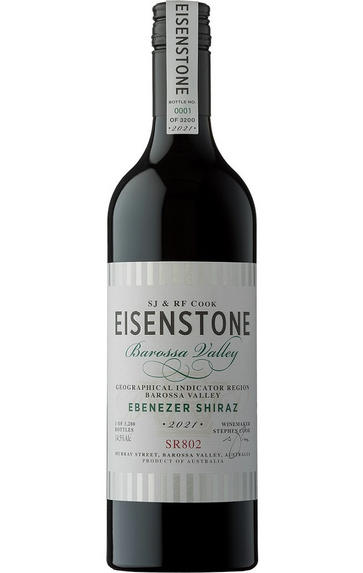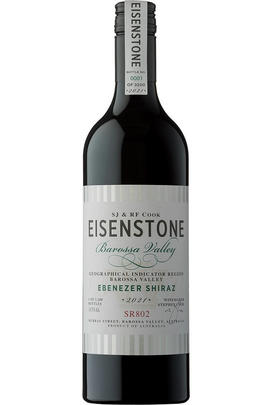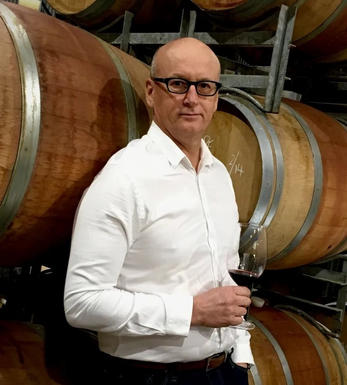
2021 Eisenstone, Ebenezer Shiraz SR802, Barossa Valley, Australia

Critics reviews
3,200 bottles filled. 14.5% alcohol, sealed under screw cap.
The 2021 Ebenezer Shiraz is really good, but it's fierce. It has fervour and intensity, in equal measure with grit and determination. The length of flavour through the black finish is impressive. It's a massive wine but balanced, which is crucial. It offers blackberry, liquorice, black earth, charcoal, resin, star anise, aniseed and crushed rocks. Rah/roar—this is big.
Drink 2023 - 2035
Erin Larkin, Wine Advocate (August 2023)
Deep, saturated red-purple colour; preserved plum, char-oak and dark chocolate aromas laced with earthy/ironstone savoury notes and lurking blackberry. It's very intense, focused and piercing in the palate; full-bodied and powerful, with deliciously chocolaty tannins and stony mineral undertones. A superb Shiraz.
Drink 2023 - 2036
Huon Hooke, The Real Review (May 2023)
About this WINE

Eisenstone
The name “Eisenstone” celebrates the rich German heritage of the Barossa Valley in Australia. It’s a blend of the German word for iron (Eisen) and the English word for stone. This combination pays homage to the Ironstone soils in which the vines grow and the stone used by the original German settlers to construct many of the iconic Barossa buildings that still stand today.
The brilliant mind behind Eisenstone is Stephen Cook, who follows a unique approach, concentrating on developing exceptional wines from a single area and a single grape type: Barossa and Shiraz. While other Australian wineries explore a multitude of grape varieties and regions, Eisenstone remains dedicated to the Barossa Valley and its signature grape, sourcing special parcels from the western ranges of the region. These vineyards are renowned for producing fuller-bodied, powerful wines with incredible depth of flavour and exceptional ageing ability.
Each vintage sees a limited quantity of each wine crafted, with each bottle bearing its own unique number.

Barossa Valley
Barossa Valley is the South Australia's wine industry's birthplace. Currently into its fifth generation, it dates back to 1839 when George Fife Angas’ South Australian Company purchased 28,000 acres at a £1 per acre and sold them onto landed gentry, mostly German Lutherans. The first vines were planted in 1843 in Bethany, and by the 1870s – with Europe ravaged by war and Phylloxera - Gladstone’s British government complemented its colonies with preferential duties.
Fortified wines, strong enough to survive the 20,000km journey, flooded the British market. Churchill followed, between the Wars, re-affirming Australia’s position as a leading supplier of ‘Empire wines’. After the Second World War, mass European immigration saw a move to lighter wines, as confirmed by Grange Hermitage’s creation during the 1950s. Stainless-steel vats and refrigeration improved the quality of the dry table wines on offer, with table wine consumption exceeding fortified for the first time in 1970.
Averaging 200 to 400 metres’ altitude, the region covers 6,500 hectares of mainly terra rossa loam over limestone, as well as some warmer, sandier sites – the Cambrian limestone being far more visible along the eastern boundary (the Barossa Ranges) with Eden Valley. Following a diagonal shape, Lyndoch at the southern end nearest Gulf St Vincent is the region’s coolest spot, benefiting from sea fogs, while Nuriootpa (further north) is warmer; hot northerlies can be offset by sea breezes. The region is also home to the country’s largest concentration of 100-year-old-vine Shiraz, Grenache and Mourvedre.
Barossa Valley Shiraz is one of the country’s most identifiable and famous red wine styles, produced to a high quality by the likes of Rockford, Elderton, Torbreck and Dean Hewitson. Grenache and Mourvèdre are two of the region’s hidden gems, often blended with Shiraz, yet occasionally released as single vineyard styles such as Hewitson’s ‘Old Garden’, whose vines date back to 1853. Cabernet Sauvignon is a less highly-regarded cultivar.
Wines are traditionally vinified in open concrete fermenters before being cleaned up and finished in American and French oak barrels or ‘puncheons’ of approximately 600 litres. Barossa Shiraz should be rich, spicy and suave, with hints of leather and pepper.

Syrah/Shiraz
A noble black grape variety grown particularly in the Northern Rhône where it produces the great red wines of Hermitage, Cote Rôtie and Cornas, and in Australia where it produces wines of startling depth and intensity. Reasonably low yields are a crucial factor for quality as is picking at optimum ripeness. Its heartland, Hermitage and Côte Rôtie, consists of 270 hectares of steeply terraced vineyards producing wines that brim with pepper, spices, tar and black treacle when young. After 5-10 years they become smooth and velvety with pronounced fruit characteristics of damsons, raspberries, blackcurrants and loganberries.
It is now grown extensively in the Southern Rhône where it is blended with Grenache and Mourvèdre to produce the great red wines of Châteauneuf du Pape and Gigondas amongst others. Its spiritual home in Australia is the Barossa Valley, where there are plantings dating as far back as 1860. Australian Shiraz tends to be sweeter than its Northern Rhône counterpart and the best examples are redolent of new leather, dark chocolate, liquorice, and prunes and display a blackcurrant lusciousness.
South African producers such as Eben Sadie are now producing world- class Shiraz wines that represent astonishing value for money.


Buying options
Add to wishlist
Description
3,200 bottles filled. 14.5% alcohol, sealed under screw cap.
The 2021 Ebenezer Shiraz is really good, but it's fierce. It has fervour and intensity, in equal measure with grit and determination. The length of flavour through the black finish is impressive. It's a massive wine but balanced, which is crucial. It offers blackberry, liquorice, black earth, charcoal, resin, star anise, aniseed and crushed rocks. Rah/roar—this is big.
Drink 2023 - 2035
Erin Larkin, Wine Advocate (August 2023)
wine at a glance
Delivery and quality guarantee